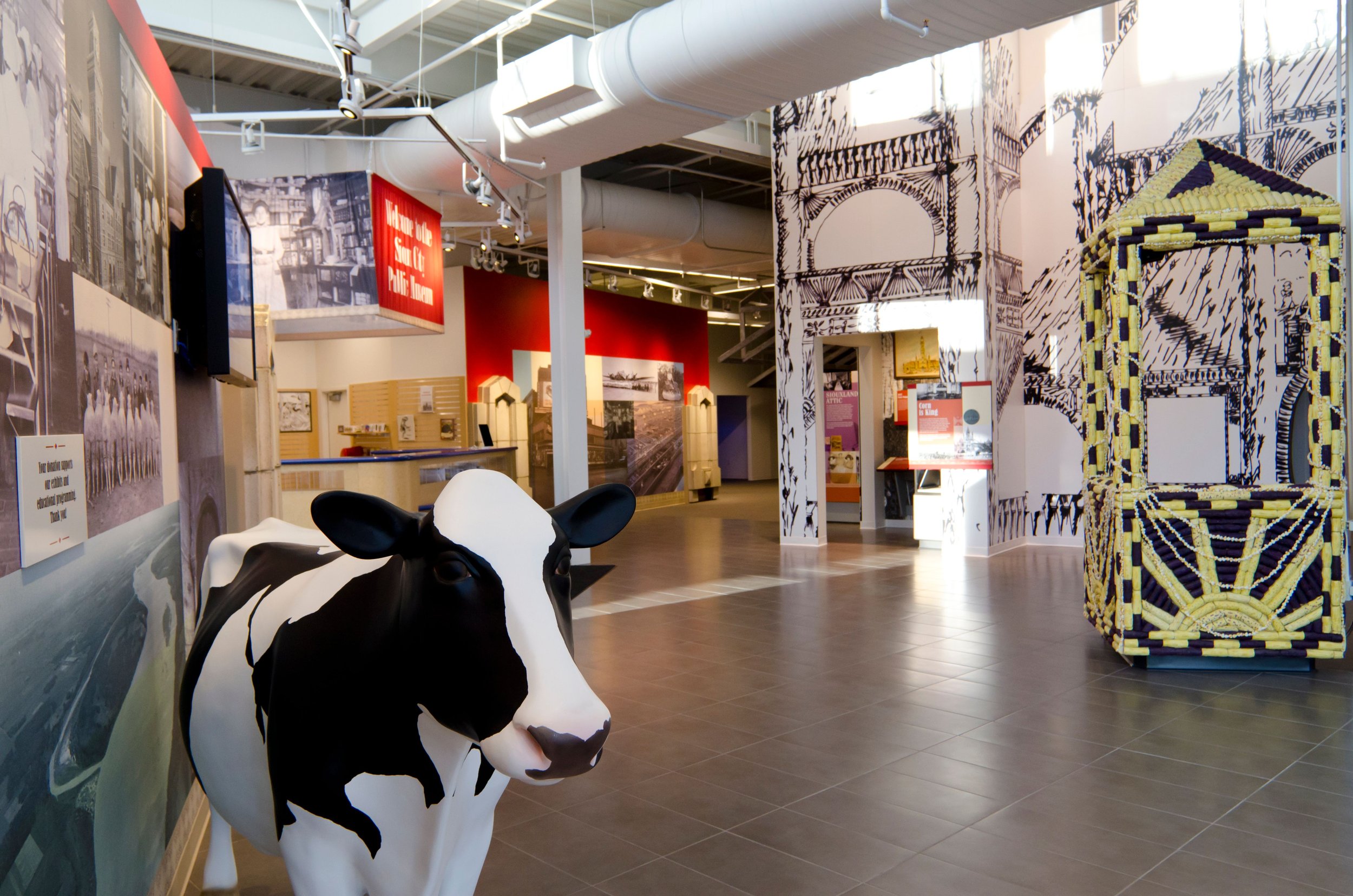
Discover Sioux
City’s Story
Sioux City Public Museum / Permanent Exhibits
Permanent Exhibits
-
A Warm Welcome
The modern glass façade, orange terra cotta, and vertical marquee create a distinctive entrance into the Sioux City Public Museum on the southwest corner of the building at 4th and Nebraska Streets. Visitors first entering the large, two-story atrium will immediately be awed by the spectacular 35-ft. tall mural of the 1887 Sioux City Corn Palace, which also serves as the orientation theater.
While waiting for a showing of the lively 12-minute Spirit of Sioux City film, visitors are encouraged to wander through the nearby Siouxland Attic which boasts a collection of unusual keepsakes, ranging from an 1880s horse-drawn sleigh to an iron lung used in the national polio epidemic that gripped Sioux City in the 1940s and 50s.
Because no attic would be complete without a ghost or two, curious visitors will be able to open a trunk to make the “spirits” of two Sioux City icons materialize. With flourish, the ghosts of bankrupted developer John Peirce and murdered prohibitionist Rev. John Haddock will recount their dramatic final days in Sioux City.

-
People & Places
After watching the orientation video in the 48-seat theater, visitors will enter the permanent exhibit gallery by the interactive map of the Siouxland region.
The Museum’s impressive collection of Native American artifacts is complimented by items on loan from the Office of the State Archeologist at the University of Iowa. Many of the artifacts from the Mill Creek culture dating to 1100 A.D. were unearthed at the Kimball site in southern Plymouth County, northwest of Stone State Park.
Early housing is represented by a Native American lodge house and tipi as well as the pioneer log cabin.
Children are encouraged to role-play in each dwelling, design a quilt using magnets and lift hatches to discover more about Sioux City history.
More hands-on experiences await in a trolley car replica with an interactive screen that allows visitors to select images from five different topics.
-
Transportation
Interactive transportation displays are also featured alongside many of the vehicles throughout the permanent gallery.
Sioux City’s first “horseless buggy,” a 1901 Oldsmobile, is joined by a 1919 Hawkeye Truck and 1957 Diamond T dump truck. The dump truck is just one of the meticulously restored vehicles donated by the Irving F. Jensen Jr. family; the full-size paver was also used by the family’s construction business.
The Jensens also donated a 1918 Mack fire truck which is similar to ones used by the Sioux City Fire Department. The fire truck is located in the shadow of two-story Disaster and Recovery Wall.
Several times each hour the multi-media screens will feature three major catastrophes that hit Sioux City: the Pelletier Department Store fire on December 23, 1904, the 1953 Floyd River Flood, and the July 19, 1989 crash of United Airlines Flight 232.
Not only does the video commemorate these tragedies, it shows the cooperative community spirit that dealt with the aftermath.
-
Agriculture
The impact of agriculture on the growth and development of Sioux City is reflected in the Sioux City Stockyards and related businesses.
A timeline traces the history of the packing industry in Sioux City from the 1850s through the closing of the John Morrell plant in 2010. Along with photographs and narratives, agriculture is showcased in a fun way with a mini-barn hands-on display and life-size livestock scattered throughout the exhibit.
Of course, that’s not all that is featured in the 12,000 ft. permanent gallery. You won’t want to miss the state-of-the-art computer-generated interactive timeline highlighting the corporate history of Gateway and IBP. The “Innovation I-Wall” was the recipient of a 2012 MUSE Award in the Interactive Kiosks category. Visitors are able to explore their history and the significance of their contributions through a movable user-controlled panel featuring video and animation.
There truly is something for curious visitors of all generations.
Experience the collection any time – with our 360° virtual tour
A hands-on dig box features replicas of terrestrial and marine fossils.
Created and constructed by Triebold Paleontology Inc., the dig box is designed to replicate an actual dig site for visitors to uncover the skeletons of dinosaurs and marine specimens found in this region.
The Colorado-based company has designed exhibits for world-class museums such as the Field Museum in Chicago.
The skeletal material in the box is cast from actual fossils excavated by Triebold while the large panorama backdrop is of actual dig sites in Montana and Kansas.
Ongoing Special Exhibitions







